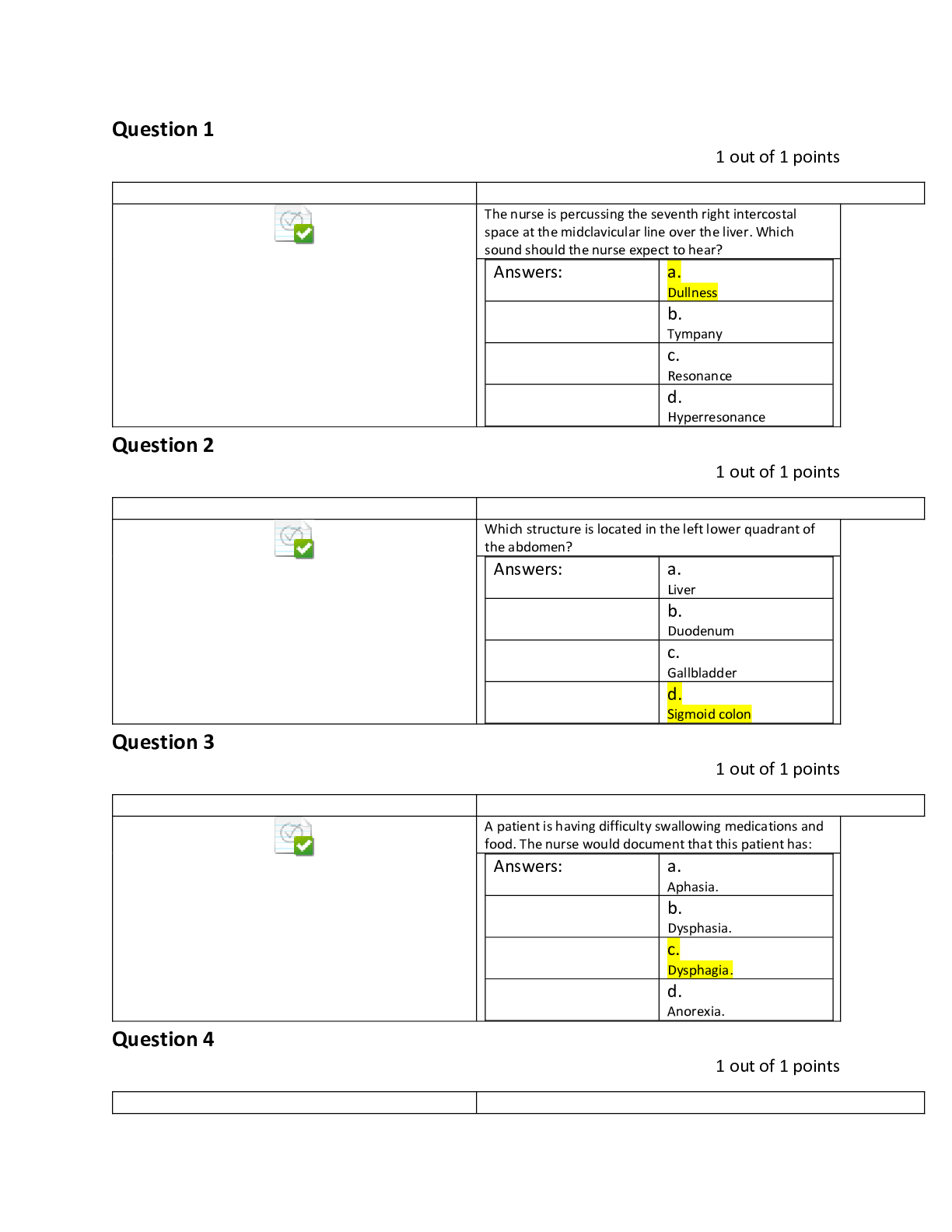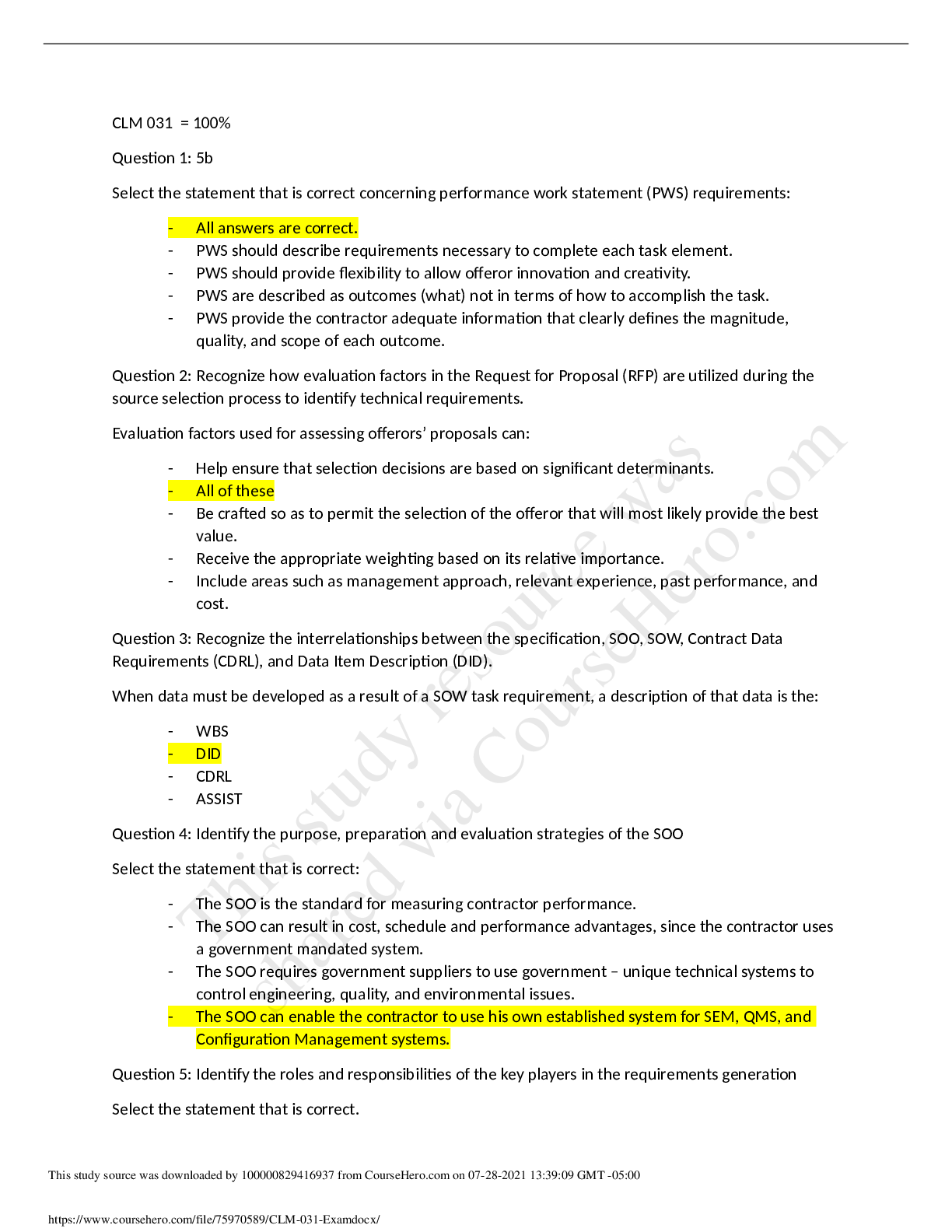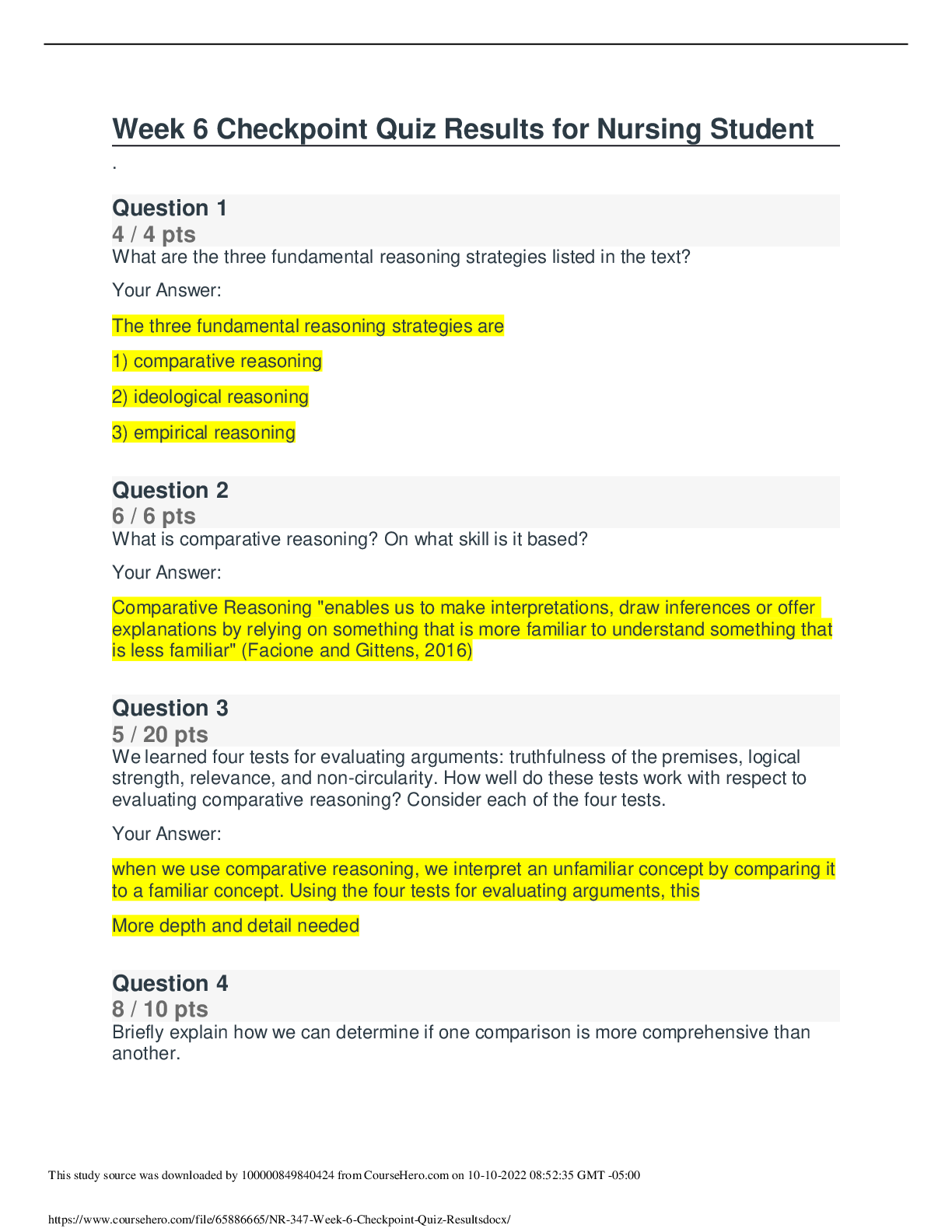*NURSING > QUESTIONS & ANSWERS > Carson-Newman University - NURS 302 > NURS 302 Pre-Exam 4 Homework Spring 2020; Complete Solution gu (All)
Carson-Newman University - NURS 302 > NURS 302 Pre-Exam 4 Homework Spring 2020; Complete Solution guide 100% A+ guide (Case studies)
Document Content and Description Below
NURS 302 Pre-Exam 4 Homework Spring 2020 Hypothalmus Anterior Pituitary End Organ CRF (corticotropin releasing hormone) GHRH (growth hormone releasing hormone) PRH (prolactin releasing hormone) TRH (t... hyrotropin releasing hormone) GnRH (gonadotropin releasing hormone) GnRH (gonadotropin releasing hormone) FSH (Follicle Stimulating Hormone) Posterior Pituitary ADH (vasopressin) Oxytocin Pancreas Insulin Glucagon Directions: Fill in the blanks on the chart below. The first row is completed as an example Directions: For each of the following disorders, identify whether the hormone level is high, low, or normal. The purpose of this activity is to help students understand primary, secondary, and tertiary endocrine disorders and how laboratory values reflect these conditions. Primary, secondary, and tertiary disorders of the endocrine system: •Primary disorders originate in the target organ •Secondary disorders originate in the pituitary causing a problem in the target organ •Tertiary disorders originate in the hypothalamus and cause a problem in both the pituitary gland and the target organ Condition Hypothalamus Anterior Pituitary End Organ Primary adrenal hyperfunction Secondary thyroid hypofunction Secondary adrenal hyperfunction Primary thyroid hyperfunction* Tertiary thyroid hypofunction Primary thyroid hypofunction* Tertiary adrenal hyperfunction Directions: Read the case study and complete the questions. Janelle, a 30-year-old woman, presents at her primary care office complaining of feeling nervous and anxious. She states that she even feels as if her heart is racing because she is “so stressed out.” Janelle would like to be prescribed anti-anxiety medication. Janelle’s height and weight measurements reveal she has lost 15 pounds in the last 6 months. She attributes her weight loss to stress. The primary care provider (PCP) examines Janelle and notes her resting heart rate is 84 beats per minute and blood pressure is 144/88 mm Hg. The PCP notes slight tremors in Janelle’s hands, and an area in her neck appears to be enlarged compared to its appearance in previous visits. Janelle lists further complaints including hair loss, diarrhea, and “feeling hot all the time.” The PCP decides to have several blood laboratory tests completed. All results are normal except the following: significantly elevated thyroid hormone levels and undetectable TSH and TRH. Further screening reveals elevated thyroid-stimulating antibodies. The PCP informs Janelle that her thyroid gland may need to be removed. If removal is necessary, thyroid hormone replacement medication will be prescribed. 1. What endocrine disorder is Janelle suffering from? 2. What led you to your conclusion? 3. Janelle says she cannot understand how one hormone can be the cause of so many symptoms: weight loss, tremors, hair loss, increased heart rate, feeling hot, etc. How would you explain the systemic effects of hormones to Janelle? 4. In addition to blood tests, what other tests can be used to evaluate endocrine disorders? 5. Although thyroid hormone replacement medication is available, discuss the challenges of exogenous versus endogenous hormones. Directions: Fill in the blanks. Dysfunction Disorder(s) Signs/Symptoms Posterior pituitary – hypopituitarism Posterior pituitary – hyperpituitarism Hypothyroidism Hyperthyroidism Anterior pituitary – hypopituitarism Anterior pituitary – hyperpituitarism Directions: Fill in the blanks. Cause Condition Effect -Nervous system disorders such as stroke, meningitis, neoplastic causes, emphysema, pneumonia, drug induced, or caused by brain surgery/injury. -Central- tumors or head trauma that injures the PP or hypothalamichypophyseal tract, pituitary surgery, inflammatory disorders, infection, exposure to chemical toxins -Nephrogenic- nephrotoxic drugs such as lithium, obstructive uropathy, ischemia of the kidney, hypokalemia, or hypocalcemia -Usually caused by a genetic mutation on chromosome 11q13 -Caused by excessive GH secretion in hyperpituitarism -Caused by GH secreting adenomas -Most common cause- Hashimotos -Risk factors- older than 50, female, pregnancy, autoimmune disease, radiation to neck, family hx, and certain drugs. -Most common cause is Grave’s disease -Subacute thyroiditis toxic multinodular goiter, toxic adenoma, iodide induced thyrotoxicosis Directions: Interpret the following laboratory results and determine what condition the results indicate. Lab Results Condition Reduced CRF Elevated ACTH Elevated cortisol Low serum calcium Low PTH Kidney failure results in poor Ca reabsorption Low serum calcium Elevated PTH Elevated CRF Elevated ACTH Low cortisol Reduced CRF Reduced ACTH Elevated cortisol ** Elevated epinephrine Elevated norepinephrine Elevated serum calcium Elevated PTH Parathyroid and Adrenal Disorders Directions: For the following disorders, describe the pathophysiology, signs and symptoms, and physical assessment findings. Tip: The disease summaries located at the end of each chapter are an excellent resource for students completing this activity. Each group may want to create a chart or visual aid to summarize their disease findings. • Cushing’s disease • Cushing’s syndrome • Adrenal insufficiency • Hyperparathyroidism • Hypoparathyroidism -Patho: lack of PTH secretion and usually the decrease in serum calcium levels. -S/S: Muscle spasms, tetany, seizures -Assessment: chvosteks, trousseaus when hypocalcemia is present • Pheochromocytoma -Patho: Extremely rare tumor of the adrenal medulla that secretes norepi and epi. -S/S: Palpitations, tremor, altered mental status, seizure, stroke signs- slurred speech Weakness -Assessment: Severe HTN, tachy, cardiac arrythmias, signs of stroke • Multiple Endocrine Neoplasia (MEN) -Patho: Caused by defective tumor suppressor gene that allows growth in several Different endocrine glands. -S/S: Depend on gland effected: parathyroid causes osteopenia, bone pain, fractures Pancreatic- excess gas acid production, diarrhea Pituitary- visual disturbances -Assessment: Depend on gland- bone pain, gynecomastia, galactorrhea, etc. Directions: Read the case study and answer the questions. Recent weight gain and fatigue have caused Tammy, a 48-year-old woman, to seek medical help. She states that she has always been in good shape and maintained her weight, but she has gained 15 pounds in the past 3 months. She tells you that she even feels too tired to exercise, something she did daily in the past. It’s not only the weight gain that is bothering Tammy. She feels her body is “changing.” Her face has a more rounded appearance than when you saw her previously. Interscapular fat deposition is also apparent. Striae have appeared on her abdomen, breasts and arms. Tammy also complains of slower than normal wound healing. She reports more facial hair, and she feels as if her voice is deepening. At first, Tammy thought some of the changes may be due to menopause, because her menstrual periods were less frequent. Now, she is not so sure. Vital signs and blood laboratory results reveal Tammy has elevated blood pressure, elevated serum glucose and cortisol. Cortisol levels are five times higher than normal. ACTH and CRF levels are undetectable. 1. What condition do you suspect Tammy has? – 2. What led you to this conclusion? – 3. Explain how her condition causes each of her signs and symptoms. 4. In addition to blood tests, what other diagnostic tests may be ordered for Tammy’s condition? 5. What is the treatment course for Tammy’s condition? 6. If Tammy’s laboratory levels had revealed elevated cortisol and elevated ACTH, how would this have altered the diagnosis? Directions: To test your retention and comprehension, answer the following prompts. 1. What are the causes of type 1 and type 2 diabetes mellitus? 2. Why are the following important in diabetes diagnosis and management: HbA1c values, postprandial glucose values, and oral glucose tolerance test? 3. Name one difference in the management of type 1 and type 2 diabetes. Directions: Create a patient scenario which successfully incorporates at least 10 of the following terms. Word Bank: oral glucose tolerance test*, fasting blood glucose*, prediabetes*, obesity*, insulin resistance*, beta cells*, autoantibodies*, HbA1c test*, metabolic syndrome*, C-peptide test*, blood glucose monitor, postprandial blood glucose, glycemic control*, type 1 diabetes*, type 2 diabetes* Directions: Several short-term complications are associated with diabetes mellitus. Identify the short-term complication indicated by the laboratory results and other information provided. Assessment Findings/Lab Results Short-term or Acute Complication Individual on insulin therapy experiences low blood glucose between 2:00 to 4:00 a.m. and morning hyperglycemia Lower than normal blood glucose, sweating, hunger, dizziness, elevated glucagon and epinephrine levels, reduced insulin levels Hypoglycemia Blood glucose >600 mg/dL, blood osmolarity >320 mOsm/L, no ketonuria, thirst, polyuria Hyperosmolar hyperglycemic syndrome Ketonuria, blood glucose >250 mg/dL, arterial pH Diabetic ketoacidosis Diabetic individual with little endogenous insulin, normal glycemic level between 2:00 to 4:00 a.m. and morning hyperglycemia Dawn phenomenon Directions: For below scenarios, provide an explanation as to why the following findings occur. Scenario A - A patient with HHS displays the following: How do you explain each of the above signs and symptoms? Scenario B - A patient with diabetic ketoacidosis displays the following: Directions: Choose 3 of the systemic long-term complications listed in Table 25-2. For each of their complications, determine “What is the worst-case scenario?” for the long-term complication and describe below. Directions: Discuss the following patient scenarios and how you would address the situation and provide patient education. 1. Maddie, age 16, has type 1 diabetes. She is unwilling to follow proper insulin usage to maintain glycemic control, because she believes following such protocol “makes her fat.” 2. Donald is a 62-year-old, overweight male who was diagnosed with type 2 diabetes 5 years ago. He has continued to put on additional weight during the past few years. He tells you that he knows he must exercise, but his feet hurt too much to do anything. 3. Jack is a young patient, age 12, who was diagnosed with type 1 diabetes 2 years ago. Jack recently began middle school and has had diabetic ketoacidosis 2 times since school began. Jack informs you that he is having difficulty remembering to take his insulin and modifying his insulin usage to meet his needs. 4. Ian is a competitive cross-country runner, who has type 1 diabetes. 5. Louis has had type 2 diabetes for 10 years. He frequently forgets to take his medications and complains he is just “too depressed” to care anymore. He is not motivated to exercise, nor eat right. He feels it does not matter because his blood sugar always seems high anyway. [Show More]
Last updated: 1 year ago
Preview 1 out of 13 pages

Reviews( 0 )
Recommended For You
*NURSING> QUESTIONS & ANSWERS > Walden University - NURS 3020 Week 4 QUIZ ABDOMEN 1 (Latest 2021) 100% Correct Study Guide, Download to Score A (All)

Walden University - NURS 3020 Week 4 QUIZ ABDOMEN 1 (Latest 2021) 100% Correct Study Guide, Download to Score A
Walden University - NURS 3020 Week 4 QUIZ ABDOMEN 1 (Latest 2021) 100% Correct Study Guide, Download to Score A
By TopScholar , Uploaded: Mar 07, 2021
$7
*NURSING> QUESTIONS & ANSWERS > NCSBN TEST BANK for the NCLEX-RN & NCLEX-PN. Contains More than 2000 Q&A Plus Review and Rationale in 517 PAGES. (All)

NCSBN TEST BANK for the NCLEX-RN & NCLEX-PN. Contains More than 2000 Q&A Plus Review and Rationale in 517 PAGES.
NCSBN TEST BANK -for the NCLEX-RN & NCLEX-PN. Updated 2022/2023. Contains More than 2000 Q&A Plus Review and Rationale in 517 PAGES. (All Testable Questions for NCLEX-RN & NCLEX-PN)
By Expert1 , Uploaded: Jul 28, 2020
$20
Business> QUESTIONS & ANSWERS > CLM 031 EXAM (All)

CLM 031 EXAM
CLM 031 = 100% Question 1: 5b Select the statement that is correct concerning performance work statement (PWS) requirements: - All answers are correct. - PWS should describe requirements necessary...
By Book Worm, Certified , Uploaded: Nov 03, 2022
$5
*NURSING> QUESTIONS & ANSWERS > PHIL 347 Week 6 Checkpoint Quiz. Score 100/100 (All)

PHIL 347 Week 6 Checkpoint Quiz. Score 100/100
Question: What are the three fundamental reasoning strategies listed in the text? Question: What is comparative reasoning? On what skill is it based? Question: We learned four tests for evaluating...
By Amanda Rosales , Uploaded: Mar 24, 2021
$7
Business> QUESTIONS & ANSWERS > BUSINESS 1007 (All)

BUSINESS 1007
BUSINESS 1007 07 Key 1. (p. 178) Managers utilize organizational resources such as employees, information, and equipment to accomplish goals. 2. (p. 178) The main job of managers today is to w...
By Kirsch , Uploaded: Oct 19, 2019
$6
Anthropology> QUESTIONS & ANSWERS > KOR 352 FA19 101 week 8 Quiz. Already Graded A (All)

KOR 352 FA19 101 week 8 Quiz. Already Graded A
KOR 352 FA19 101: Week 8 Quiz Question 1 (0.25 points) Which of the following is not true of Kim and Finch’s observations during their field research in South Korea from 1997 to 2000? Question 1 o...
By Kirsch , Uploaded: Oct 17, 2019
$9
E-Commerce> QUESTIONS & ANSWERS > ESOC 316 Digital Commerce - University Of Arizona. Midterm Quiz. 20 Q&A. 100% Score (All)

ESOC 316 Digital Commerce - University Of Arizona. Midterm Quiz. 20 Q&A. 100% Score
ESOC 316 Digital Commerce - University Of Arizona. Midterm Quiz. 20 Q&A. 100% Score ESOC316 MIDTERM QUIZQuestion 6 (1 point) Saved Information has several properties that make information goods...
By Kirsch , Uploaded: Oct 15, 2019
$9.5
Marketing> QUESTIONS & ANSWERS > Marketing Management Chapter 2 to Chapter 10 Q&A (All)

Marketing Management Chapter 2 to Chapter 10 Q&A
Chapter 2 to Chapter 10 Chapter 2: Developing Marketing Strategies and Plans GENERAL CONCEPT QUESTIONS Multiple Choice 66 Chapter 1: Marketing: Managing Profitable Customer Relationships...
By Kirsch , Uploaded: Oct 14, 2019
$10
Marketing> QUESTIONS & ANSWERS > MKT 530 Customer Relationship Management. 155 Questions and Answers (All)

MKT 530 Customer Relationship Management. 155 Questions and Answers
MKT 530 All Questions and Answers MULTIPLE CHOICE. Choose the one alternative that best completes the statement or answers the question. 1) As the manager of an organization that is att...
By Kirsch , Uploaded: Oct 14, 2019
$10
Art> QUESTIONS & ANSWERS > MAS 337 Exam 1. Graded A (All)

MAS 337 Exam 1. Graded A
MAS 337 Exam 1 Match the son with its corresponding region. 1.Oaxaca 2.Veracruz 3.Michoacan 4.Jalisco 5.Hidalgo 1. Son istemeno 2. Son Jarocho 3. Son Abajeno 4. Son Jalisciense 5. Son Huast...
By Kirsch , Uploaded: Oct 14, 2019
$6
Document information
Connected school, study & course
About the document
Uploaded On
Dec 16, 2020
Number of pages
13
Written in
Additional information
This document has been written for:
Uploaded
Dec 16, 2020
Downloads
0
Views
51






